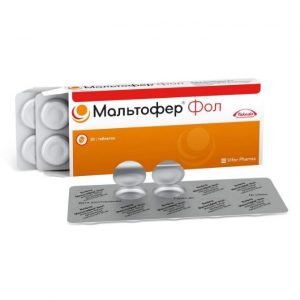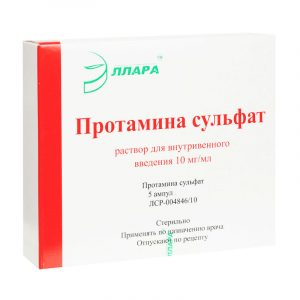Description
Latin name
Tranexam
Release form
Ampules 50 mg / ml. 5 ml of the drug in an ampoule of neutral glass, 5 ampoules in a blister strip packaging of PVC film and aluminum foil. 1 or 2 blister strip packaging along with instructions for use are placed in a cardboard box.
Each 20, 50 or 100 blister packs, respectively from 10, 25 and 50 instructions for use are placed in cardboard boxes or in boxes of corrugated cardboard (for a hospital).
packaging 10 pcs
Pharmacological action of
Tranexamic acid is an antifibrinolytic agent that specifically inhibits the activation of profibrinolysin (plasminogen) and its conversion to fibrinolysin (plasmin). It has local and systemic hemostatic effects in bleeding associated with increased fibrinolysis, as well as anti-inflammatory, anti-allergic, anti-infectious and anti-tumor effects due to the suppression of the formation of kinins and other active peptides involved in allergic and inflammatory reactions. The experiment confirmed the intrinsic analgesic activity of tranexamic acid, as well as the over-total potentiating effect with respect to the analgesic activity of opiates.
Pharmacokinetics
Distributed in tissues relatively evenly (with the exception of cerebrospinal fluid, where the concentration is 1/10 of the plasma), it passes through the placental and blood-brain barrier into breast milk (about 1% of the concentration in the mother s plasma). It is found in seminal fluid, where it reduces fibrinolytic activity, but does not affect sperm migration. The initial distribution volume is 9-12 liters. Communication with plasma proteins (profibrinolysin) – less than 3%. In the blood, about 3% is associated with protein (plasminogen).
The concentration in cerebrospinal fluid is 1/10 of the plasma. The total renal clearance is equal to plasma.
Antifibrinolytic concentration in various tissues lasts 17 hours, in plasma – up to 7-8 hours.
A small part is metabolized. The concentration-time curve has a three-phase shape with a half-life in the terminal phase of 2 hours. The total renal clearance is equal to the plasma (7 l / h).
It is excreted by the kidneys (the main way is glomerular filtration) – more than 95% unchanged during the first 12 hours. Two metabolites of tranexamic acid were identified: N-acetylated and deaminated derivatives. With impaired renal function, there is a risk of cumulation of tranexamic acid.
Indications
Bleeding or risk of bleeding due to increased fibrinolysis, generalized (bleeding during operations and in the postoperative period, postpartum hemorrhage, manual separation of the placenta, chorionic detachment, bleeding during pregnancy, malignant neoplasms of the pancreas and prostate gland, hemophilia, hemorrhagic complications of fibrinolytic therapy, thrombocytopenic purpura, leukemia, liver disease, streptokinase), and local (uterine, cervical conization for carcinoma, nasal, pulmonary, gastrointestinal bleeding e., hematuria, bleeding after prostatectomy, tooth extraction in patients with hemorrhagic diathesis). Bladder surgery Surgical manipulations in case of a systemic inflammatory reaction (sepsis, peritonitis, pancreatic necrosis, severe and moderate severity of gestosis, shock of various etiologies, etc. critical conditions).
Contraindications
Hypersensitivity to the drug, subarachnoid hemorrhage. With caution – thrombohemorrhagic complications (in combination with heparin and indirect anticoagulants), thrombosis (deep vein thrombophlebitis, thromboembolic syndrome, myocardial infarction, myocardial infarction), color vision disorders, hematuria from the upper urinary tract, urinary tract obstruction (possible obstruction (cumulation is possible).
Pregnancy and lactation
There have been no adequate and strictly controlled clinical trials of the safety of tranexamic acid during pregnancy, so the intended benefit and potential risk of therapy should be carefully evaluated when prescribed.
Composition
Active ingredient
Tranexamic acid – 50.00 g
Excipients
Water for injection – up to 1000 ml.
Side effects
Allergic reactions (rash, itching, urticaria), dyspeptic symptoms (anorexia, nausea, vomiting, heartburn, diarrhea), dizziness, weakness, drowsiness, tachycardia, chest pain, rapid hypotension ( , violation of color vision, blurred visual perception of thrombosis or thromboembolism (the risk of developing is minimal).
Lekarstvennoe
Farmatsevtychesky nesovmestym Interaction with blood, soluble, soderzhaschymy penicillin, urokynazoy, hypertenzyvn my assets (norÑpynefrynom dezoksyÑpynefrynom hydrochloride, metarmynom bytartratom), dipyridamole tetracycline, diazepam. Hemostatic drugs, hemocoagulase potentiate the activation of thrombus formation.
Storage Conditions
List B. At a temperature not exceeding 25 ° C. Keep out of reach of children.
Shelf life
3 years.
Deystvuyushtee substance
Traneksamovaya Chisloth
Terms and conditions
prescription
Dosage form
infusion solution
Moscow Endocrine Plant, Russia




